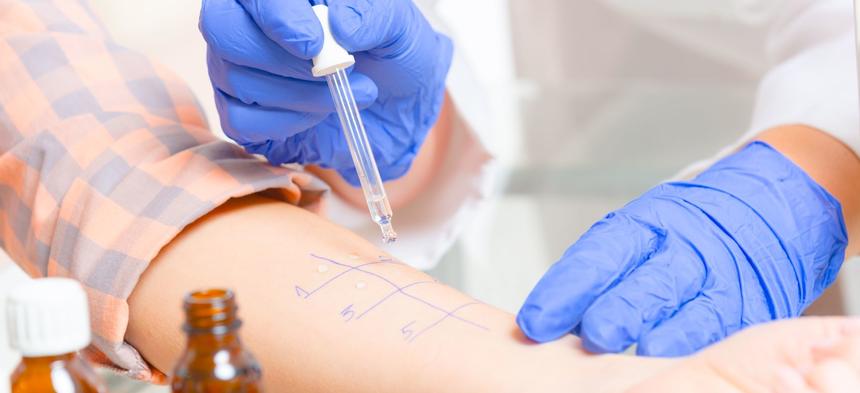Skin Prick Tests
Allergists often use a skin prick test to measure the presence of IgE antibodies, or an allergic response, for the suspect food allergen.

Food allergy symptoms are caused by the interaction between a food allergen and an antibody known as IgE (immunoglobulin E). To diagnose a food allergy, your allergist may use a skin prick test (SPT) to measure the presence of IgE antibodies for the suspect food. SPTs are inexpensive, produce immediate results, and can be performed in the doctor’s office.
During this test, the allergist places a drop of solution containing the food allergen on your forearm or back. (When testing fruits or vegetables, fresh food may be used instead of a solution.) Using a small plastic probe or needle, the doctor gently pricks or scratches the skin to allow a tiny amount of the solution to enter just below the surface. The SPT is generally not painful and there is no bleeding. The scratching on the surface of the skin feels similar to a fingernail scratch.
Depending on your case history, you may be tested for one food or several. Results usually appear within 15 to 20 minutes. Positive results are indicated by a wheal – a raised white bump surrounded by a small circle of itchy red skin. In general, a large wheal is more likely to indicate a true food allergy, but the size of the wheal is not always an accurate predictor. If no wheal appears, it is unlikely that you are allergic to the test food.
Accuracy of Skin Prick Tests
SPTs seldom produce “false negatives” (erroneous results indicating that you are not allergic to a food, even though you really are). Negative results almost always mean that you are not allergic to the food that was tested.
Positive tests, however, are not always accurate. About 50-60 percent of all SPTs yield “false positive” results, meaning that the test shows positive even though you are not really allergic to the food being tested. These results occur for different reasons:
It is possible that the skin prick test detects IgE antibodies against undigested food proteins that are not necessarily associated with a true food allergy; this leads to a false positive response.
Members of a food “family” often share similar proteins. For example, if you are allergic to peanuts, your tests may show a positive response to other members of the legume family, such as green beans, even if eating green beans has never been a problem for you. This is known as cross-reactivity. The test is positive because it recognizes a similar protein in peanuts and green beans. But the test hasn’t detected the real culprit—another, different protein that is found only in peanuts.
False positive skin test responses can also occur in some individuals who have overreactive skin. The individual can ingest the food without having an actual allergy to this food. This can lead to a false positive response.
Despite the high rate of false positives, in the hands of an experienced allergist, skin and blood tests are extremely helpful. For example, if your medical history suggests that you have had several reactions after eating soy products, and skin prick tests show a positive reaction to soy proteins, it is very likely that you do have a soy allergy. Therefore, a thorough medical history, including the individual's symptoms when eating a particular food, is crucial in interpreting the skin test results. This is helpful in determining if a food allergy is present.
About 50-60 percent of all SPTs yield “false positive” results, meaning that the test shows positive even though you are not really allergic to the food being tested.
If you are taking antihistamines, it’s important to keep in mind that they can interfere with skin tests. If stopping your medication for a short time will make your symptoms worse, your doctor may choose to perform a blood test.
Other Proven Testing Methods:
- Blood test (to measure specific IgE antibodies to food allergens)
- Oral food challenge
- Food elimination diet


